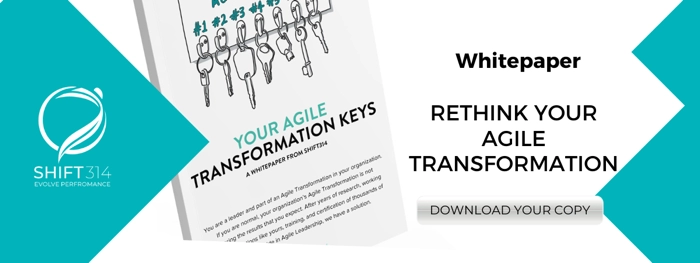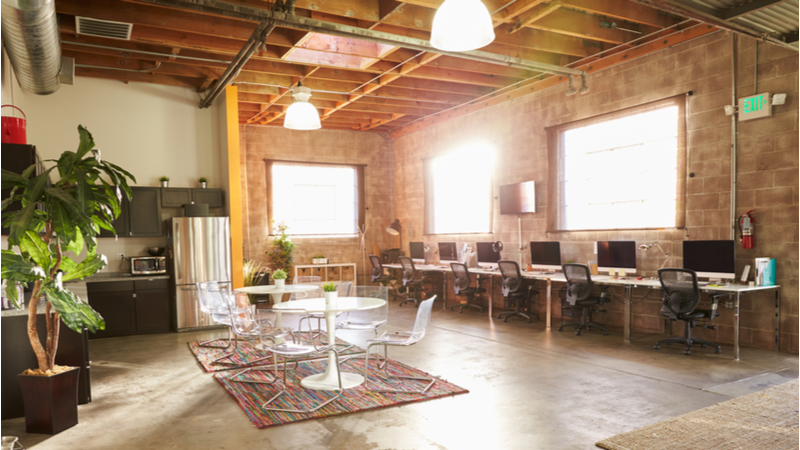The Agile work environment is an environment that supports Agile ways of working and Agile ways of being. Naturally, the next question is, “Well, what does that mean? What kind of characteristics make an Agile work environment?”
The core of Agile is really about people coming together and collaborating, learning as they go along the way, and responding to change. Alistair Cockburn has a great explanation of people collaborating in his book “Agile Software Development”.
It’s also an environment that supports collaboration. An Agile work environment could be defined as an environment that supports extraordinary collaboration. So, what does that mean? What is extraordinary collaboration? Here are some practical examples of what makes an Agile work environment.
The Core Elements of an Agile Work Environment

Caves and Commons
There’s an old idea that goes back to extreme programming, one of the early variants of Agile. It’s called “caves and commons.”
The “commons” area is an area where everyone can come together, like a very long table so that everyone could see everyone else. They can talk or just reach out as needed. Everyone is in direct communication with each other and have immediate access to their coworkers.

The commons also include areas for the team to meet, to project things on the wall, to have presentations, have discussions, have meetings, even places that can support doing a shared “mob” programming where all the developers work together on the same piece of code. Some commons have comfy areas like sofas where people can just sit, have a coffee, and chat.
The “caves” are separate areas where people can have alone time, make phone calls, or focus on projects without interruption. The caves could be a place where someone could be on their own or a smaller area for two or three team members to get together and collaborate. Together, these two make up an Agile work environment.

Remote Tools
Now let’s talk about remote tools. It’s about having places for direct communication, super easy ways for the whole team to stay in contact with each other. At the touch of a button, having a video call session with someone or multiple people. Having very transparent access, automatic visibility, who’s at their desk, who’s not.
Some really good teams set things up so they can still do pair programming – working on the exact same coding session and using video support, and passing control back and forth. And of course, there’s technology to support this. There are also collaboration services for doing things like using sticky notes or doing shared drawing, and so on. One of my favorites is shared document creation with Google Docs.
Moving Beyond the Standard Workstation
If you look at a standard office workstation, it’s designed optimally for one person, and if you have two people in the space, it’s horrible.
Why? Because there’s no straight desk for two people to sit at. It’s designed so the computer’s in the corner, so only one person can access it. The traditional office environment is set up for anti-collaboration.
We worked with an executive who used his own budget to take out all the anti-collaboration desks and replace them with six-foot wide desks with computers in the middle. They also provided floater stools so that anybody from any other team could come by and sit with them at a computer and start doing work together. It completely unlocked collaboration not just within the team but with other groups that would come and visit to get work done.
Agile Work Environment Anti-patterns

Only Open Space
When transitioning to Agile, some people get this crazy notion that everything needs to be open concept. “We’ll just put all these people at a team table together, and we’ll put the next team right there and the next team right there, and we’ll save so much office space!” It’s only open space, and that’s actually an anti-pattern, and it’s the opposite of an Agile work environment.
When you have only open space, guess what? We’ve lost our caves, we’ve lost our shared team space that we need to collaborate properly. If our team’s here, and the next team’s 10 feet away, guess what? We’re going to hear all those conversations. And we don’t care about them because they’re on a different team. It doesn’t make any sense. When we get a lot of noise around us that has nothing to do with our work, that’s the opposite of collaboration. That’s anti-collaboration.
Most modern office designs that are trying to be Agile-friendly or collaboration-oriented are horrible. The best team environments are where each team has its own segregated area with acoustic separation from all the other teams. Even having acoustic separation within their team, so you can have those smaller cave areas so that some team members can be really loud brainstorming without disrupting the rest of the team.
Not Understanding Team Needs
The number one problem is people don’t understand what the needs of teams are. The number two problem is that even if they understand, it turns out that the people who are in charge of productivity are not running the show. The people who are running the show are the accountants, and all they look at is cost.

Specifically, what’s the cost per square foot of the office? And how many square feet do I give each individual person? So, now people suddenly think, “Ooh, Agile. I can pack people in. I can save money.”
But a healthy Agile work environment is about increasing the amount of space per person, so that there are good collaboration zones. Anytime you’re compressing people, it’s actually treating people like herd animals – like cattle.
Guess what happens when you treat people like cattle? Performance goes down. The way to have performance go up is to create amazing Agile work environments that support the commons and the caves. That’s what a great Agile work environment is about. It means spending more money on people so they have space and places to collaborate.
When you get people cramped together, it doesn’t create good outcomes. It breaks my heart, how often I’ve seen horrific environments foisted on people in the name of progress.
See Tom De Marco’s “Peopleware” for an in-depth exploration of this topic.
Hot Desking with No Permanent Desks
The next anti-pattern is an open office environment where people no longer have permanent seats. “Hey, everyone’s got a hotel desk. Every day, you come in and you have a totally new desk.”

In some unique situations, that makes sense. But for most people, it makes the best performance sense to have teams with your dedicated team room. Let them decorate it. Let them bring in their plants, let them paint the walls the color they want, let them bring in a Tardis if that makes them happy. Happy employees means more productivity, more collaboration, more results.
Letting teams and people bring their whole self to work and express themselves in their team areas allows your workplace to become really alive. That’s going to unlock a positive sentiment in the employees, as well as creativity. It’s really going to support performance in extraordinary ways. And it doesn’t cost that much to let teams paint the walls, for heaven’s sake.
Don’t Try Agile Unless You Can Get People Sitting Together
An important lesson that I learned is, don’t even bother to try Agile unless you can get people sitting together. If you’re really trying to move to an Agile way of working and create a shift in the performance of your team, none of this will be possible if people don’t collaborate.
When people start sitting together, it builds communication and creates the kind of accidental interpersonal connections that build trust, safety, and connection. People start to identify psychologically with their team instead of their different departmental groups. And it starts to build that human bond that will allow the team to function and perform highly.

“Sitting Together” in a Remote Environment
Some of you might be thinking, “How does this apply in a remote environment?” Well, it’s all about creating spaces for people to connect. We actually have a whole article about this called The Remote Leader’s Guide to Psychological Safety, where we talk about where are the ways you can start bringing your team together to help them connect together as a team. When you are virtual, it’s about creating new ways of connecting online to replace in-person experience.
It also means having those great collaboration tools to make sure that you have those spaces for collaboration, and it’s very, very easy and frictionless for people to collaborate, because they have all the tooling at their fingertips. So, the analog for the remote space then is, “Don’t even bother trying to introduce Agile to remote teams unless you have the right tools in place for collaboration.”
Final Thoughts
An Agile work environment can make or break the productivity of people. Despite its high level of impact and importance, it’s unfortunate that most organizations fail to adequately address employees.
What you don’t need is another “office redesign” project that is done the same way as the last one. It starts with good intentions but get lost in translation. The only way out of this minefield is through an upgrade of your organizational culture to one that truly values people and their importance in the creation of products and services. Unfortunately, most organizations are doomed to terrible work environments until they find the need or will to change how they function to a more evolved culture.



